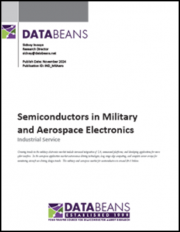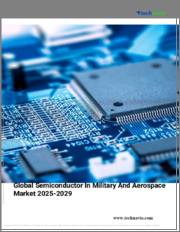
|
시장보고서
상품코드
1628134
항공우주용 반도체 시장 : 시장 기회, 성장 촉진요인, 산업 동향 분석, 예측(2025-2034년)Aerospace Semiconductor Market Opportunity, Growth Drivers, Industry Trend Analysis, and Forecast 2025 - 2034 |
||||||
세계의 항공우주용 반도체 시장은 2024년 84억 달러로 평가되었으며, 2025년부터 2034년까지 8.4%의 연평균 복합 성장률(CAGR)로 견조하게 성장할 것으로 예측됩니다.
이 성장의 원동력이 되고 있는 것은 에너지 효율이 높은 반도체에 대한 수요 증가입니다. 이 반도체는 항공우주 시스템의 운영 수명을 향상시키는 동시에 무게와 연료 소비를 줄이는 중요한 역할을 합니다. 에너지 낭비를 최소화함으로써 이러한 반도체는 에너지 자원이 제한되어 전력 효율이 필수적인 인공위성, 무인 항공기 및 항공기의 성능 요구 사항을 지원합니다. 항공우주산업은 최소 전력 사용으로 고성능을 선호하기 때문에 저파워 반도체 기술의 혁신이 시장을 진전시키고 제조업체가 엄격한 규제 기준과 지속가능성 목표를 달성하는 데 도움이 됩니다.
시장은 유형별로 이산 소자, 광 소자, 마이크로파 소자, 센서, 집적 회로(IC), 하이브리드 IC로 구분됩니다. 그 중에서도 이산 장치는 2034년까지 시장 규모가 325억 달러 이상에 달할 것으로 예상되어 큰 성장이 예상되고 있습니다. 이러한 구성 요소는 항공우주 용도에서 전력 조정, 신호 처리 및 회로 보호 관리에 필수적입니다. 다이오드 및 트랜지스터와 같은 이산 반도체는 고급 항공우주 시스템에서 효율적인 전력 관리, 안정적인 통신 및 안정적인 모터 제어를 보장하는 데 필수적입니다. 가혹한 조건 하에서도 확실하게 동작하고 방열을 관리할 수 있기 때문에 진화하는 항공우주 분야에서 필수적인 컴포넌트로 자리매김하고 있습니다.
기술 측면에서 시장은 표면실장기술(SMT)과 스루홀기술(THT)로 나뉩니다. THT는 2025년부터 2034년의 CAGR이 12.5% 이상으로 예측되어 가장 급성장하는 분야로 예상됩니다. 이 성장의 원동력이 되고 있는 것은 이 기술이 가지는 탁월한 내구성과 신뢰성이며, 진동이나 충격, 극단적인 온도에 노출되는 항공우주 환경에서는 극히 중요합니다. THT 부품은 기계적 강도가 뛰어나 안정된 장기 접속이 가능하기 때문에 고출력 및 고주파 용도에 선호되고 있습니다.
| 시장 범위 | |
|---|---|
| 시작년 | 2024년 |
| 예측 연도 | 2025-2034년 |
| 시작 금액 | 84억 달러 |
| 예측 금액 | 187억 달러 |
| CAGR | 8.4% |
북미가 최대 시장 점유율을 차지하며 2023년 세계 항공우주용 반도체 시장의 43%를 차지했습니다. 이 지역의 이점은 확립된 항공우주 산업과 선진 반도체 기술에 대한 지속적인 투자로 인한 것입니다. 군사, 상업, 자율항공에 강한 초점을 맞추고, 북미는 항공우주 일렉트로닉스의 기술 혁신을 추진하고 있으며, 이 급속히 진화하는 시장의 주요 기업으로서의 지위를 확립하고 있습니다.
목차
제1장 조사 방법 및 조사 범위
제2장 주요 요약
제3장 업계 인사이트
- 생태계 분석
- 밸류체인에 영향을 주는 요인
- 이익률 분석
- 파괴
- 장래의 전망
- 제조업체
- 유통업체
- 공급자의 상황
- 이익률 분석
- 주요 뉴스 및 대처
- 규제 상황
- 영향요인
- 성장 촉진요인
- 항공우주용 반도체 용도에서 전력 효율 향상
- 위성 통신 수요 증가
- 항공우주 분야에서 IoT 채용 증가
- 전기 항공기 및 하이브리드 항공기의 성장
- 항공전자공학시스템용 AI의 진보
- 업계의 잠재적 위험 및 과제
- 긴 설계 사이클이 신기술의 채용 지연 초래
- 경기 후퇴나 예산의 영향 가능성 상승
- 성장 촉진요인
- 성장 가능성 분석
- Porter's Five Forces 분석
- PESTEL 분석
제4장 경쟁 구도
- 서문
- 기업 점유율 분석
- 경쟁 포지셔닝 매트릭스
- 전략 전망 매트릭스
제5장 시장 추계 및 예측 : 유형별(2021-2034년)
- 주요 동향
- 이산 소자
- 다이오드
- 트랜지스터
- 사이리스터
- 모듈
- 광학 디바이스
- LED
- 수광소자
- 레이저
- 마이크로파 디바이스
- 센서
- IC(집적회로)
- 메모리
- MPU
- 로직 IC
- 아날로그 IC
- 하이브리드 IC
제6장 시장 추계 및 예측 : 기술별(2021-2034년)
- 주요 동향
- 표면실장기술(SMT)
- 스루홀기술(THT)
제7장 기술별 시장 추계 및 예측 : 용도별(2021-2034년)
- 주요 동향
- 어비오닉스 시스템과 비행제어
- 통신 및 접속 솔루션
- 배전 및 관리
- 네비게이션 센싱 기술
- 안전 및 긴급 시스템
- 항공기 엔터테인먼트 시스템
제8장 시장 추계 및 예측 : 최종 용도별(2021-2034년)
- 주요 동향
- 민간 항공기
- 군용기
- 위성 발사 로켓
- 기타
제9장 시장 추계 및 예측 : 지역별(2021-2034년)
- 주요 동향
- 북미
- 미국
- 캐나다
- 유럽
- 영국
- 독일
- 프랑스
- 이탈리아
- 스페인
- 러시아
- 아시아태평양
- 중국
- 인도
- 일본
- 한국
- 호주
- 라틴아메리카
- 브라질
- 멕시코
- 중동 및 아프리카
- 아랍에미리트(UAE)
- 남아프리카
- 사우디아라비아
제10장 기업 프로파일
- Advanced Micro Devices Inc.(Xilinx Inc.)
- Analog Devices(ADI)
- Broadcom Inc.
- Crane Aerospace & Electronics
- Honeywell Aerospace
- Infineon Technologies
- MACOM Technology Solutions, Inc.
- Mercury Systems, Inc.
- Microchip Technology
- Northrop Grumman Corporation
- NXP Semiconductors
- ON Semiconductor
- Renesas Electronics
- RTX Corporation
- Skyworks Solutions Inc.
- STMicroelectronics
- Teledyne Technologies Inc.,
- Texas Instruments(TI)
- TT Electronics
- Vishay Intertechnology, Inc.
The Global Aerospace Semiconductor Market, valued at USD 8.4 billion in 2024, is projected to grow at a robust CAGR of 8.4% from 2025 to 2034. This growth is fueled by the increasing demand for energy-efficient semiconductors, which play a crucial role in enhancing the operational lifespan of aerospace systems while reducing weight and fuel consumption. By minimizing energy waste, these semiconductors support the performance requirements of satellites, drones, and aircraft, where power efficiency is essential due to limited energy resources. As the aerospace industry prioritizes high performance with minimal power usage, innovations in low-power semiconductor technology are driving the market forward, helping manufacturers meet stringent regulatory standards and sustainability goals.
The market is segmented by type into discrete devices, optical devices, microwave devices, sensors, integrated circuits (ICs), and hybrid ICs. Among these, discrete devices are poised for significant growth, with an expected market value exceeding USD 32.5 billion by 2034. These components are critical for managing power regulation, signal processing, and circuit protection in aerospace applications. Discrete semiconductors, such as diodes and transistors, are essential to ensure efficient power management, reliable communication, and stable motor controls in advanced aerospace systems. Their ability to operate reliably under extreme conditions and manage heat dissipation positions them as a vital component in the evolving aerospace sector.
On the technological front, the market is divided into surface-mount technology (SMT) and through-hole technology (THT). THT is expected to be the fastest-growing segment, with a projected CAGR of over 12.5% between 2025 and 2034. This growth is driven by the technology's exceptional durability and reliability, which are critical in aerospace environments that experience high levels of vibration, shock, and temperature extremes. THT components are favored for their superior mechanical strength and ability to provide stable, long-term connections, making them preferred for high-power and high-frequency applications.
| Market Scope | |
|---|---|
| Start Year | 2024 |
| Forecast Year | 2025-2034 |
| Start Value | $8.4 Billion |
| Forecast Value | $18.7 Billion |
| CAGR | 8.4% |
North America holds the largest market share, accounting for 43% of the global aerospace semiconductor market in 2023. The region's dominance is attributed to its well-established aerospace industry and ongoing investments in advanced semiconductor technologies. With a strong focus on military, commercial, and autonomous aviation, North America continues to drive innovation in aerospace electronics, positioning itself as a key player in this rapidly evolving market.
Table of Contents
Chapter 1 Methodology & Scope
- 1.1 Market scope & definition
- 1.2 Base estimates & calculations
- 1.3 Forecast calculation
- 1.4 Data sources
- 1.4.1 Primary
- 1.4.2 Secondary
- 1.4.2.1 Paid sources
- 1.4.2.2 Public sources
Chapter 2 Executive Summary
- 2.1 Industry 360° synopsis, 2022-2034
Chapter 3 Industry Insights
- 3.1 Industry ecosystem analysis
- 3.1.1 Factor affecting the value chain
- 3.1.2 Profit margin analysis
- 3.1.3 Disruptions
- 3.1.4 Future outlook
- 3.1.5 Manufacturers
- 3.1.6 Distributors
- 3.2 Supplier landscape
- 3.3 Profit margin analysis
- 3.4 Key news & initiatives
- 3.5 Regulatory landscape
- 3.6 Impact forces
- 3.6.1 Growth drivers
- 3.6.1.1 Increased power efficiency in aerospace semiconductor applications
- 3.6.1.2 Rising demand for satellite communication
- 3.6.1.3 Increased adoption of IoT in aerospace
- 3.6.1.4 Growth in electric and hybrid aircraft
- 3.6.1.5 Advancements in AI for avionics systems
- 3.6.2 Industry pitfalls & challenges
- 3.6.2.1 Long design cycles delaying new technology adoption
- 3.6.2.2 High sensitivity to economic downturns and budgets
- 3.6.1 Growth drivers
- 3.7 Growth potential analysis
- 3.8 Porter's analysis
- 3.9 PESTEL analysis
Chapter 4 Competitive Landscape, 2024
- 4.1 Introduction
- 4.2 Company market share analysis
- 4.3 Competitive positioning matrix
- 4.4 Strategic outlook matrix
Chapter 5 Market Estimates & Forecast, By Type, 2022-2034 (USD Billion)
- 5.1 Key trends
- 5.2 Discrete devices
- 5.2.1 Diodes
- 5.2.2 Transistors
- 5.2.3 Thyristors
- 5.2.4 Modules
- 5.3 Optical devices
- 5.3.1 LEDs
- 5.3.2 Photodetectors
- 5.3.3 Lasers
- 5.4 Microwave devices
- 5.5 Sensors
- 5.6 ICs (Integrated Circuits)
- 5.6.1 Memories
- 5.6.2 MPUs
- 5.6.3 Logic ICs
- 5.6.4 Analog ICs
- 5.7 Hybrid ICs
Chapter 6 Market Estimates & Forecast, By Technology, 2022-2034 (USD Billion)
- 6.1 Key trends
- 6.2 Surface-Mount Technology (SMT)
- 6.3 Through-Hole Technology (THT)
Chapter 7 Market Estimates & Forecast, By Application, 2022-2034 (USD Billion)
- 7.1 Key trends
- 7.2 Avionics systems & flight control
- 7.3 Communication & connectivity solutions
- 7.4 Power distribution & management
- 7.5 Navigation & sensing technologies
- 7.6 Safety & emergency systems
- 7.7 Aircraft entertainment systems
Chapter 8 Market Estimates & Forecast, By End Use, 2022-2034 (USD Billion)
- 8.1 Key trends
- 8.2 Commercial aircraft
- 8.3 Military aircraft
- 8.4 Satellite launch vehicle
- 8.5 Others
Chapter 9 Market Estimates & Forecast, By Region, 2022-2034 (USD Billion)
- 9.1 Key trends
- 9.2 North America
- 9.2.1 U.S.
- 9.2.2 Canada
- 9.3 Europe
- 9.3.1 UK
- 9.3.2 Germany
- 9.3.3 France
- 9.3.4 Italy
- 9.3.5 Spain
- 9.3.6 Russia
- 9.4 Asia Pacific
- 9.4.1 China
- 9.4.2 India
- 9.4.3 Japan
- 9.4.4 South Korea
- 9.4.5 Australia
- 9.5 Latin America
- 9.5.1 Brazil
- 9.5.2 Mexico
- 9.6 MEA
- 9.6.1 UAE
- 9.6.2 South Africa
- 9.6.3 Saudi Arabia
Chapter 10 Company Profiles
- 10.1 Advanced Micro Devices Inc. (Xilinx Inc.)
- 10.2 Analog Devices (ADI)
- 10.3 Broadcom Inc.
- 10.4 Crane Aerospace & Electronics
- 10.5 Honeywell Aerospace
- 10.6 Infineon Technologies
- 10.7 MACOM Technology Solutions, Inc.
- 10.8 Mercury Systems, Inc.
- 10.9 Microchip Technology
- 10.10 Northrop Grumman Corporation
- 10.11 NXP Semiconductors
- 10.12 ON Semiconductor
- 10.13 Renesas Electronics
- 10.14 RTX Corporation
- 10.15 Skyworks Solutions Inc.
- 10.16 STMicroelectronics
- 10.17 Teledyne Technologies Inc.,
- 10.18 Texas Instruments (TI)
- 10.19 TT Electronics
- 10.20 Vishay Intertechnology, Inc.
















